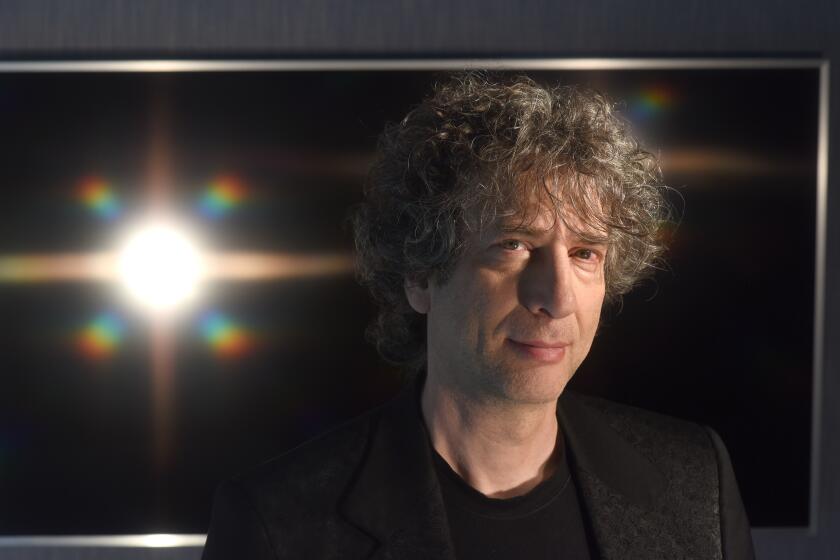Going native
- Share via
“JAMESTOWN” is a wild, violent, mordantly hilarious retelling of how the first permanent English settlement in the New World came into being, and unlike the version extolled in countless middle-school textbooks, Matthew Sharpe doesn’t gloss over its influence on those who were already there. Indeed, the Indians’ perspective on the events of 400 years ago is what gives Sharpe’s satire such ferocious bite.
Set in the indeterminately near future, a ragtag band of employees of the Manhattan Company (roughly analogous to the colonial-era venture capitalist Virginia Company of London) leaves the city in an armored bus as the Chrysler Building disappears in a cloud of dust. Their mission is to cross the wasteland between New York and Virginia, make contact with the local Indian population and exploit their natural resources. The settlers prove to be as dangerous to one another as the hazards of I-95, but they manage to reach the Chesapeake, establish a camp of sorts and prepare to make contact with the Indians.
The first locals to approach the bus are Pocahontas, Chief Powhatan’s daughter, and her uncle and physician, Sidney Feingold. Johnny Rolfe, the Manhattanites’ communications officer, is ordered to greet the natives, which he does through interpretive dance. Charmed, Pocahontas leads the party to a grove of red-skinned women. In a scene that is not likely to be re-created in a school play anytime soon, the women clean, clothe, feed and sexually pleasure the interlopers before sending them back to their bus. “If those are that town’s girls,” Johnny writes, “I’m not so sure I’m keen to meet its boys.”
The following morning the warriors unleash an arrow attack on the woozy settlers, piercing one of them in the lower intestine. The Indians are held off with automatic weapons fire and the New Yorkers retreat to the safety of the bus. Johnny is called upon to mediate a truce with the Indians, which ensues, though neither side stops scheming to destroy the other. Johnny’s loyalty to the Manhattan Company is challenged by its erratic management and by the realization that he is developing feelings for Pocahontas. However, love at first sight it’s not:
“The girl was spectacularly ugly. She was short and thin and of an unnaturally reddish hue. Her face was as wide as it was long, with big, thick cheekbones and pockmarked skin. Her black hair came halfway down her arms in two dense, gobbed-up plaits that looked like a pair of large, dead rodents.”
The first section of the novel alternates between the perspectives of Johnny and Pocahontas so that by the time they meet, the reader is completely won over by Pocahontas’ effusive charm. But at 19 years old, she’s got problems: She hasn’t gotten her period yet, which causes her father great embarrassment since all of the men in her village want to bed her because she is the chief’s daughter. Pocahontas is an exceptional character: part smartass, part wood sprite and completely captivating:
“I tiptoed, real quiet, Indian style, through tall corn stalks all dolled up in dew like girls in rhinestones. ‘Hello, you glorious young woman,’ they said to me. Corn loves me. Plants in general love me. Soil, rich with human blood, loves me. Clouds love me. The sky loves me, though I know she wouldn’t hesitate to crush me dead.”
With language like this, Pocahontas steals the show. It would have been easy to present her as a cipher, a Joan of Arc type, shouldering the burden of history the moment she steps out of the cornfield. Instead, Sharpe has given us a wildly precocious and eminently likable girl-on-the-verge who is several steps ahead of every male she meets.
Throughout the novel, Johnny and Pocahontas correspond in a variety of media that make use of the written, rather than the spoken, word. This form of expression is appropriate, for much of what we know about the original settlers of Jamestown comes from the letters they sent back to the home office. The scenes in Sharpe’s novel so closely parallel the original events that the more one knows about the origins of Jamestown the greater one’s enjoyment of the novel is likely to be. For instance, there really was a John Rolfe and everyone from Christopher Newport to John Smith is represented in the novel, only this time they carry automatic weapons. Although Sharpe’s novel stands on its own, aping the past in the guise of the present allows us to look past the correspondents’ stilted 17th century prose and imagine them as they must have been: desperate, scared out of their minds and entirely ill-suited to the task at hand.
In many ways the story of Jamestown is the story of America. It doesn’t give anything away to say that even though things go very badly for the settlers, it’s much worse for the Indians. But the explorers survive and return to a New York imagined through the lens of a post-Apocalyptic video game. Manhattan is at war with Brooklyn and the streets are strewn with rubble. The air is brown, the water undrinkable, but they still shoot movies in Central Park. (Pocahontas is being used as the model for a recruitment video to lure young men to sign on with the Manhattan Company for further adventures in Indian country.)
Although there are plenty of parallels between 1607 London and 2007 New York, ultimately “Jamestown” is an utterly implausible tale. After all, no credible governing agency would blindly send its representatives to a perilous land they could never hope to understand or control simply for the purpose of the short-term exploitation of its natural resources.
Thankfully, Sharpe’s vividly realized farce plays much better as a novel than as the lead story on the nightly news. *
More to Read
Sign up for our Book Club newsletter
Get the latest news, events and more from the Los Angeles Times Book Club, and help us get L.A. reading and talking.
You may occasionally receive promotional content from the Los Angeles Times.









